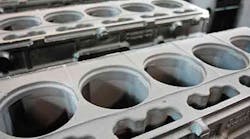Navistar International Corporation will close its Indianapolis iron foundry by the third quarter of 2015, eliminating approximately 180 jobs but reducing the truck and engine builder’s operating costs by about $13 million/year. The company took an $11-million Q4 2014 charge against earnings to cover employee separation benefits, pensions and other “post-retirement contractual termination benefits,” inventory reserves, and other costs.
Navistar reported a loss of $72 million for Q4, including the restructuring and other costs (e.g., product warranties), more than analysts expected, though it also reported sales for the quarter rose 9% to $3 billion.
In addition to the Q4 restructuring costs, Navistar estimated up to $40 million in additional charges during Q1 and Q2 2015, for accelerated depreciation related to the closing and related impacts during the first half of 2015.
The Indianapolis plant has been operating since 1939, casting 250,000 tons/year of engine blocks, cylinder heads, housings, front covers and other parts for the adjacent Navistar truck plant, and for other locations.
It had been marked for closing in 2010, but a new, five-year labor agreement with the United Steelworkers and a change in strategy preserved the operation. Navistar reduced the payroll and then operated it as a unit of PurePower Technologies, a diesel technology and emissions control company Navistar acquired in 2009.
Subsequently, the foundry licensed SinterCast technology and initiated compacted graphite iron production for engines, adding that option to its gray and ductile iron products.
"Over the last two years, we've taken a number of steps to strengthen our business and position the company for a return to profitability and long-term success," stated Persio Lisboa, Navistar's president of operations. "We've determined that leveraging our suppliers for these components will reduce our engine costs, improve our overall manufacturing capacity utilization, and free up additional resources to invest in our core North America truck and parts business."
Navistar stated it would source its casting requirements “from the supply base.” The company continues to cast commercial vehicle and engine parts in ductile iron at a foundry in Waukesha, WI.
"Closing a facility is a difficult decision because of its impact on the many great people who've been part of our company," according to Lisboa, who promised Navistar would “treat people with dignity and respect throughout this process."









